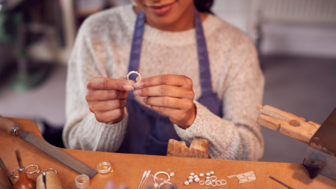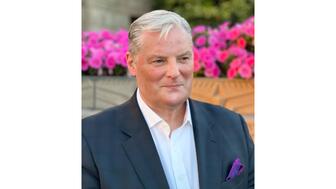The new store in the upscale Iguatemi São Paulo mall is the storied brand’s first flagship in Brazil.
A Hands-on Lesson in Telling Gemstones Apart
Senior Editor Brecken Branstrator recounts what she learned at an AGS Conclave education session on identifying gemstones presented by Gem-A.

The American Gem Society knocks it out of the park every year for their Conclave event. The keynote speakers are top-notch, and the education sessions cover a wide variety of topics presented by experts in the industry.
Held in Washington, D.C. this year, Conclave again was full of great sessions, from a panel on bridal trends, to updates on diamond prices and grading reports, to a fascinating session on diamonds and their healing powers.
A particularly cool one that I got to attend was held Friday by The Gemmological Association of Great Britain (Gem-A).
In “Separating Similar-Looking Stones,” Gem-A’s Claire Mitchell began by walking session attendees through the steps used to identify a stone, starting with observation and then working through the instruments that can help jewelers tell apart similar-looking stones.
I loved this session because it was a hands-on experience--half the session was a presentation and the other half had us using the instruments ourselves. (I think a lot of people were excited about this session, as it had a waiting list and attendees were lined up before it started. I was lucky enough to just make it in and get a seat with equipment.)
First, Mitchell walked us through what kind of observations can be made before using any instruments.
For example, inclusions such bubbles and swirls or molding marks that indicate a paste glass might tell you that a gemstone is man-made.
Inclusions in natural stones can help indicate what the stone might be as well, such as “horsetail inclusions” found in demantoid garnets or “lily pads” that show up in peridot.
Next, Mitchell walked us through the use of instruments such as a polariscope, spectroscope and a dichroscope.
We got to use all three on gemstone samples provided so we could see for ourselves how each worked and what the stones looked like through the instruments.
The polariscope, for example, can tell you if a stone has double or single refraction, while a spectroscope is a diagnostic tool showing a spectrum of colors that is “like having a bar code for a gemstone” to help with identification.
My personal favorite was the Chelsea Color Filter, which is a dichromatic filter that transmits two wavelengths only to help identify certain green, red and blue stones, as well as detecting dyes in certain gems.
Above is a picture of three different blue stones--aquamarine, topaz and spinel--under the filter.
I
While I’m always trying to see if I can guess what a gemstone is when I see it, Gem-A stressed that there should always be more tests involved to figure out a stone’s true identity. This session definitely made me want to go out and get some of these instruments for myself.
The Latest

The pieces span from the Art Deco period to the 1970s and will go up for auction at the Paris Jewels sale later this month.

The Grammy-winning singer-songwriter, who is set to perform at Coachella this month, also debuted a curated selection from the brand.

GIA’s labs in Dubai and Hong Kong are now accepting larger diamonds in light of the “logistical challenges” presented by the new tariffs.


The introductions include the Land-Dweller, Rolex’s first new model since 2012, as well as several new dials for its classic timepieces.

Bench jewelers spend years honing their skills, Jewelers of America’s Certification validates their talents.

Cowlishaw earned a degree in horology after serving in World War II, working at one of the first Zales stores in Tulsa, Oklahoma.

Bonhams will offer the “Kat Florence Lumina” at its May 22 jewelry auction.

In March 2022, the men went into a jewelry store in Beverly Hills and smashed the display cases with sledgehammers and crowbars.

The 51 unique watches from Sotheby’s three-day sale and immersive exhibition all found buyers, with the top lot selling for $229,955.

The company has acquired Australian jewelry insurance provider Jewellers Loop.

Beau Lotto’s immersive presentation will be a blend of neuroscience, art, and entertainment.

A pink topaz Belle Époque pendant-brooch and a Victorian Egyptian Revival choker were also highlights at a recent Anderson & Garland sale.

The event, which will co-locate with the Monterey Bay Jade Festival, will bring education sessions focused on jade to the United States.

The charm is a celebration of springtime as April showers bring May flowers with the piece’s cluster of diamond raindrops.

The National Retail Federation expects retail sales growth to return to pre-pandemic levels as consumers continue to face inflation.

The 4-carat, old mine brilliant-cut diamond engagement ring was co-designed by Willis and New York City-based brand Karina Noel.

Rio Tinto unearthed the diamond at its Diavik mine in Canada’s Northwest Territories.

The multisensory experience, open April 8-13, will feature the brand’s silver creations among dream-like scenes of natural landscapes.

The virtual event will take place April 7 at 3 p.m.

The pieces in “Animali Tarallo” portray animals from stingrays to elephants through portraits and interpretations of their patterns.

Parent company Saks Global said the iconic location will be open through the holiday season as it decides what to do with the space.

Ronald Winston, son of Harry Winston, donated the diamonds to the Smithsonian National Museum of Natural History in Washington, D.C.

The educational event will take place in Charlotte, North Carolina, this May.

The independent jeweler first opened its doors in 1888.






























